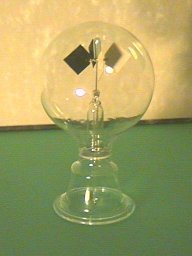The light engine (radiometer) is composed of a glass bulb, filled with low pressure gas and containing a turning wheel with alternating black and white blades. If you light up the bulb, the wheel start to be in motion.
Explanation
Switch on a spotlight and point it towards the bulb: the light is reflected by the white blades while adsorbed by the black ones; thus the temperature of the black blades gets higher than that of the white ones. From the kinetic theory of gases, we know that the mean kinetic energy of a particle increases with temperature: when a molecule of gas hits the dark face of a blade, it bounces back with higher speed than it would have when hitting a white blade.

|


